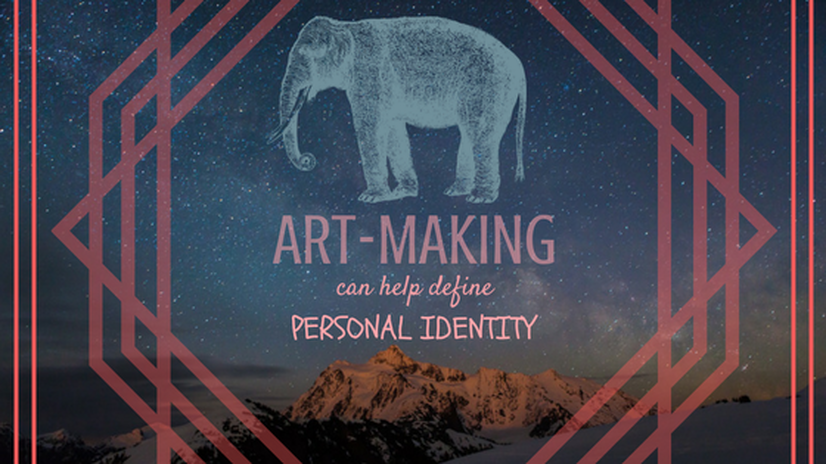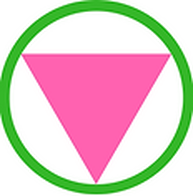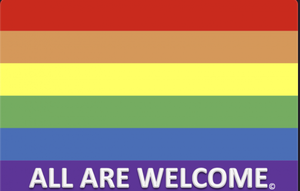Making things is hard. I'm busy. Why make art?
Okay, you have work to do, kids to take care of, bills to pay, events to plan.... You're busy, I get it. Why would you make time to "create?" I don't think many people believe art-making is bad. Still, I do see many people minimize the value of creating in their lives.
The creative process easily connects you with the unconscious aspects of the self. It's a lot more difficult to access these shadowy parts using logical reasoning, as they function on a nonverbal-symbolic level. The point is, the creative process is essential to developing self-awareness.
I'm going to make a hard case for creating. I'm hoping after reading this you'll have a better idea of how art-making might specifically help you on a mind-body-spirit level.
Art-making expands your mind
When I say mind, I mean the process through which you are aware of your world -- your thoughts, feelings, perceptions. Art-making helps develop engagement with and exploration of your own consciousness.
"Um, I'm already conscious..." you might say, why would I need to develop this at all?
Yes, yes. And... your mind is way more vast than you may give it credit for. Intentional art-making can help bring thoughts and feelings into consciousness that were formerly unconscious, AND incredibly, it allows you to interact and with these intangible experiences in a concrete and tactile way!
HOW COOL, RIGHT?
Many art therapists before me have written about this phenomenon; it is the basis for how art therapy works! Edith Kramer, notably, wrote extensively about the healing process of transforming and containing internal experience through creating and artistic sublimation (Kramer, 2000).
My elephant painting reflected to me a dynamic in my busy life that I wasn't even aware was happening.
This ended up being very useful to me in acknowledging my experience at the time, and helped me be more present and helpful with my clients.
How can art-making access these deep places?
- Art-making prompts you to represent experience symbolically, with color and texture, giving a visual language that can be more articulate than words alone. This can result in expressions that are incredibly meaningful and guiding! Art therapy pioneer Harriet Wadeson writes that one reason art can be so articulate is that it shows simultaneous and complex relationships in space -- portraying many feelings and connections all at once in a way that linear verbal language cannot (Wadeson, 2010).
- Art-making engages your sense of touch in a way that can reignite old forgotten memories or experience. For example, squishing clay can evoke memories of childhood, and could bring up unresolved feelings from that time period.
- Art-making can prompt a "flow" state in which you are so in the zone that time seems to fly by (Csikszentmihalyi, 1990). Decisions can seem effortless and from an intuitive place. In my opinion, flow state is so powerful because it accesses personal intuition and empowerment -- interacting with a sense of self that is 100% authentic.
- Art materials are powerful -- I've said this before, but it's so important. Art materials range in their fluidity and how difficult they are to control. More fluid materials, for example like paint or wet clay, are thought to be more "affective" -- meaning they can prompt the release of intensely held or protected emotions (Lusebrink, 1990). For someone who has a hard time expressing sadness, for example, the fluidity of painting with watercolors might catalyze engagement with this constricted emotion.
Disclaimer -- this can get intense! Sometimes you may not be ready to experience something that was unconscious, or may need help processing what newly conscious feelings may mean. This is where an art therapist can be incredibly helpful. Read more about what art therapy is, and how to find a therapist.
Art-making can help define personal identity
One beautiful example of this is Carl Jung's Red Book. The Red Book is Jung's a visual journal in which he documents his thoughts and visual responses to his engagement with his imagination. Jung was able to define figures through this process that represented different parts of his self, and actually engaged with these symbols in meaningful ways.
Maybe that is a little far out there for some. Simply put, art-making is personal symbol-making, and creating personal symbols can help create meaning in life.
Dr. Bruce Moon (2007) believes that, "all artworks are metaphoric depictions of the people who create them." From this perspective our artworks reflect who we are and what we are going through in meaningful ways. If we choose to interact with these symbolic mirrors, we can gain real insight into our own experience.
Imagine I ask three different people to draw a tree. The first person draws a pine tree with needles scattered at its base. The second draws a cherry blossom full of bright blooms settled on a cliffside. The third person draws an autumn tree with leaves just starting to turn yellow. Each of these people have different experiences and emotions leading them to the moment that they drew this tree.
Asking these people to draw a tree prompts them to consciously or unconsciously address themes of growth, change, life, death, and environment. For one person their tree might be symbolic of a fresh start after an experience that left them feeling bare. For another person, their tree might represent a tree they used to climb as a child and a significant moment or relationship in their life. For someone else it could mean the start of a new career venture. In any case a single symbol can be deeply evocative and personally significant. Expressing these symbols visually can be both empowering and releasing, helping to clarify the different parts of self and experience.
This is an example of the kind of process-oriented work that we use in art therapy.
With the right intention, art-making can help define your understanding of your self, your emotions, and your place in this big wide universe.
Art-making can help heal emotional wounds.
It can feel markedly safer (and often more articulate) to express traumatic or difficult experience through metaphor than through verbal communication. Expressed color and shape have the capacity to evoke the intensity of emotional experience. Art can show how something felt, rather than just tell the facts of what happened.
Our culture is primarily focused on finding "happiness." Emotions seen as "negative" or "weak" (like sadness, anger, and fear) are often pushed down and away from consciousness in an effort to appear "okay" or "stable." For some people it can be hard to feel these emotions, and can seem impossible to express them. Creative expression can be a means to begin to access and work with these emotions if given the allowance and intention.
There are a million reasons why art-making helps heal trauma. Here are a few:
- Post-traumatic art-making can help awaken shut-down emotions, and help contain overwhelming ones. Art-making can encapsulate a difficult experience into an object or image outside of one's self (Malchiodi, 2015).
- When you make art, you get to decide what goes where, what color things will be, how things will look. -- in many circumstances it can be healing to have artistic control when the rest of your life or experience feels out of your hands. Therapeutic art-making is inherently a judgement-free process, providing space for empowering authentic expression (Steele & Malchiodi, 2012).
- The repetitive, rhythmic, and tactile nature of art-making is regulating and calming for a traumatized nervous system (Gaskill & Perry, 2014; Chapman, 2014). For people with traumatic experience, the body can react with intense fear responses in everyday situations. The creative process can help rewire the brain to manage these emotions effectively. This is a huge topic, but perhaps we will revisit this in a future post.
- Finally, art-making can empower people to live in the wake of traumatic experience.
Creativity is for everyone, but please reach out to a therapist or art therapist if you need help processing what comes up.
Here's the point...
Creating can help give meaning to your life if you let it.
You might be thinking, okay but how do I even start? Stay tuned for our next post, which will give you some approachable ideas to get your creativity flowing at home!

-Sarah Klein, MA, LPCC
Art Therapist and Co-Owner at Open Mind Holistics Learn more about Sarah in this blog post, or on her bio page. |
- Bolwerk A, Mack-Andrick J, Lang FR, Dörfler A, Maihöfner C (2014). How Art Changes Your Brain: Differential Effects of Visual Art Production and Cognitive Art Evaluation on Functional Brain Connectivity. PLoS ONE 9(7): e101035. doi:10.1371/journal.pone.0101035
- Chapman, L. (2014). Neurobiologically informed trauma art therapy: Understanding mechanisms of change. New York, NY: W. W. Norton & Company.
- Csikszentmihalyi, M. (1990). Flow: The psychology of optimal experience. New York: Harper and Row.
- Gaskill, R., & Perry, B. (2014). The neurological power of play: Using the neurosequential model of therapeutics to guide play in the healing process. In C. Malchiodi & D. Crenshaw (Eds.), Creative arts and play therapy for attachment problems (pp. 178-194). New York, NY: Guilford Press.
- Jung, C. G., The Red Book: Liber Novus. Ed. S. Shamdasani, tr. M. Kyburz, J. Peck and S. Shamdasani. New York: W. W. Norton.
- Lusebrink, V. (1990). Imagery and visual expression in therapy. New York: Plenum Press.
- Malchiodi, C. (2015). Neurobiology, creative interventions, and childhood trauma. In C. Malchiodi (Ed.), Creative interventions with traumatized children (2nd ed., pp. 3-23). New York, NY: Guilford Press.
- Moon, B. (2007). The role of metaphor in art therapy: Theory, method, and experience. Springfield, IL: Charles C Thomas Publisher, LTD.
- Steele, W., & Malchiodi, C. (2012). Trauma-informed practices with children and adolescents. New York, NY: Routledge.








 RSS Feed
RSS Feed


